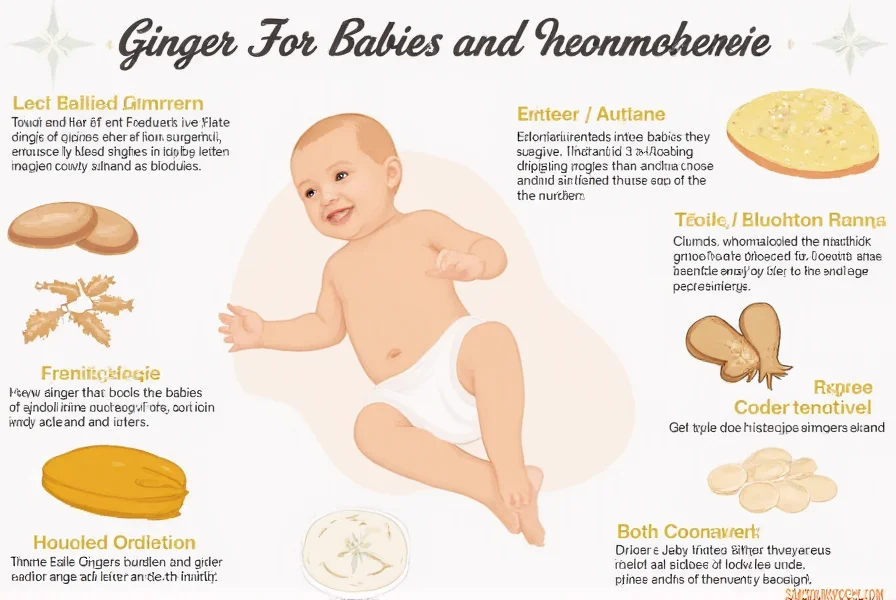Parents often search for natural remedies when caring for their little ones, and ginger frequently appears as a potential solution for common infant discomforts. Understanding the appropriate use of ginger for babies requires careful consideration of age, health status, and proper administration methods. This comprehensive guide provides evidence-based information to help parents make informed decisions about ginger and infant care.
Understanding Ginger Safety for Infants
Ginger contains bioactive compounds like gingerols that provide its distinctive flavor and potential health benefits. However, infants' developing digestive systems and immature liver function make them particularly vulnerable to herbal substances. The American Academy of Pediatrics states there is insufficient evidence to support ginger use in infants under 12 months, and many pediatricians recommend avoiding it entirely during this critical developmental period.
For toddlers between 1-2 years, small amounts of ginger incorporated into food may be acceptable with pediatrician approval. This might include tiny amounts in baked goods or diluted in food. However, concentrated forms like ginger tea, supplements, or essential oils should be strictly avoided due to potential adverse effects.
Common Misconceptions About Ginger Baby Remedies
Many parents seek ginger for babies experiencing colic, teething discomfort, or digestive issues. While traditional medicine sometimes recommends ginger for these concerns, scientific evidence supporting its safety and effectiveness for infants remains limited. Research published in the Journal of Pediatric Gastroenterology and Nutrition indicates that herbal remedies like ginger haven't been sufficiently studied for infant use, making their risk-benefit profile uncertain.
| Age Group | Recommended Ginger Use | Potential Risks |
|---|---|---|
| Under 6 months | Avoid completely | Digestive distress, allergic reaction |
| 6-12 months | Avoid except minimal food ingredient | Interference with nutrient absorption |
| 12-24 months | Minimal amounts in food only | Mouth irritation, digestive upset |
| 2+ years | Small amounts with pediatrician approval | Blood thinning effects, medication interactions |
When Ginger Might Be Considered for Older Infants
For children over 12 months, some pediatricians may approve minimal ginger use in specific circumstances. The most common ginger baby teething remedy applications include:
- Diluted ginger tea (1 part ginger to 10 parts water) for occasional nausea
- Small amounts of cooked ginger in food for digestive support
- Ginger-infused bath water for mild muscle discomfort (external use only)
Even in these cases, the amount should be extremely limited - no more than 1/8 teaspoon of freshly grated ginger per serving for toddlers. Always introduce new substances gradually and watch for adverse reactions. The safest ginger for baby colic approach remains consulting your pediatrician rather than self-administering remedies.
Significant Risks of Ginger for Infants
Ginger's blood-thinning properties present particular concerns for infants, especially those with bleeding disorders or scheduled for surgery. Research in the journal Pediatrics indicates ginger can interact with certain medications, including anticoagulants and diabetes medications that some children might require. Other potential issues include:
- Mouth and throat irritation from raw ginger
- Digestive upset including heartburn or diarrhea
- Allergic reactions (rare but possible)
- Interference with iron absorption
Infants with gastroesophageal reflux disease (GERD) should particularly avoid ginger, as it may worsen symptoms. The ginger baby reflux remedy commonly suggested online lacks scientific support and could potentially exacerbate discomfort.
Safe Alternatives to Ginger for Common Infant Concerns
For parents seeking natural solutions for infant discomfort, several evidence-based alternatives exist that pose fewer risks than ginger for babies:
- For colic: Probiotic drops (specific strains like L. reuteri), gentle tummy massage, and controlled crying techniques
- For teething: Chilled (not frozen) teething rings, clean finger massage, and over-the-counter pain relief approved for infants
- For digestive issues: Small, frequent feedings, proper burping techniques, and pediatrician-approved probiotics
When considering any natural remedies for ginger baby concerns, remember that "natural" doesn't automatically mean safe for infants. Always discuss potential remedies with your child's healthcare provider before implementation.

Consulting Your Pediatrician About Ginger
Before introducing ginger to your child's environment, schedule a consultation with your pediatrician. Come prepared with specific questions about:
- Appropriate age to consider ginger
- Safe preparation methods
- Maximum safe quantities
- Potential interactions with current medications
- Warning signs of adverse reactions
Document any reactions your child has to ginger, including timing, symptoms, and severity. This information helps your healthcare provider make informed recommendations about future use. Remember that each child's tolerance and reaction to herbal substances varies significantly.











 浙公网安备
33010002000092号
浙公网安备
33010002000092号 浙B2-20120091-4
浙B2-20120091-4